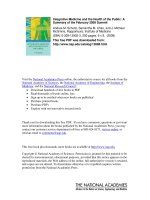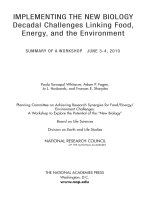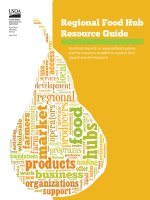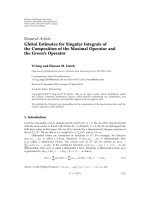plants food medicine and the green earth
Bạn đang xem bản rút gọn của tài liệu. Xem và tải ngay bản đầy đủ của tài liệu tại đây (38.82 MB, 241 trang )
Food, Medicine, and the Green Earth
PlantsPlants
Food, Medicine, and the Green Earth
Michael Allaby
Illustrations by Richard Garratt
PLANTS: Food, Medicine, and the Green Earth
Copyright © 2010 by Michael Allaby
All rights reserved. No part of this book may be reproduced or utilized in any form or by any means,
electronic or mechanical, including photocopying, recording, or by any information storage or
retrieval systems, without permission in writing from the publisher. For information contact:
Facts On File, Inc.
An imprint of Infobase Publishing
132 West 31st Street
New York NY 10001
Library of Congress Cataloging-in-Publication Data
Allaby, Michael.
Plants : food, medicine, and the green earth / Michael Allaby ; illustrations by Richard Garratt.
p. cm. — (Discovering the Earth)
Includes bibliographical references and index.
ISBN 978-0-8160-6102-0 (hardcover)
ISBN 978-1-4381-2967-9 (e-book)
1. Plants—History. 2. Botany—History. I. Facts on File, Inc. II. Title. III. Series: Allaby, Michael.
Discovering the Earth.
QK45.2.A45 2010
580—dc22 2009018930
Facts On File books are available at special discounts when purchased in bulk quantities for
businesses, associations, institutions, or sales promotions. Please call our Special Sales
Department in New York at (212) 967-8800 or (800) 322-8755.
You can fi nd Facts On File on the World Wide Web at tsonfi le.com
Excerpts included herewith have been reprinted by permission of the copyright holders; the author
has made every eff ort to contact copyright holders. e publishers will be glad to rectify, in future
editions, any errors or omissions brought to their notice.
Text design by Annie O’Donnell
Composition by Hermitage Publishing Services
Illustrations by Richard Garratt
Photo research by Tobi Zausner, Ph.D.
Cover printed by Times Off set (M) Sdn Bhd, Shah Alam, Selangor
Book printed and bound by Times Off set (M) Sdn Bhd, Shah Alam, Selangor
Date printed: March, 2010
Printed in Malaysia
10 9 8 7 6 5 4 3 2 1
is book is printed on acid-free paper.
xiv+226_DTE-Plants.indd 4 6/8/10 10:39:55 AM
Contents
Preface ix
Acknowledgments xi
Introduction xii
3
Chapter 1
the Father oF Botany 1
Aristotle and His Natural History 2
eophrastus, the Father of Botany 4
Medicine and Plants 6
Pedanius Dioscorides and His Catalog of Medicinal Plants 7
What Is a Pharmacopoeia?
Alexander the Great and His Empire 10
Pliny, Preserving Knowledge 13
John Ray and His Encyclopedia of Plant Life 16
3
Chapter 2
herBals and physiC Gardens 19
Shennong, the Divine Farmer 20
e Aztec Herbal 22
Albert the Great and the Structure of Plants 24
Konrad von Megenberg and His Illustrated Herbal 26
Conrad Gessner, the German Pliny 27
Rembert Dodoens and the First Flemish Herbal 30
John Gerard and His Herbal 32
Nicholas Culpeper and His Herbal Best Seller 34
Leonhard Fuchs, Fuchsia, and the First Botanical Glossary 38
e Bauhin Family 42
Monastic Gardens 44
e Apothecaries’ Garden at Chelsea 45
e Doctrine of Signatures 48
Contents
3
Chapter 3
BotaniCal Gardens and herBaria 51
Identifying Plants: e Herbal Becomes the Flora 51
Formal Gardens, Restoring Order to a Chaotic World 53
Lancelot “Capability” Brown
Luca Ghini and How to Press Flowers 57
e Rise of the Herbarium 60
Pisa, Padua, and Florence, the First Botanical Gardens 62
Carolus Clusius, the Leiden Botanical Garden, and the Tulip 64
Tulipomania
Sir Henry Capel, Princess Augusta, and the Royal Botanic
Gardens at Kew 67
Sir Joseph Banks, Unofficial Director of Kew 70
Sir William Hooker, the First Official Director 72
Jean-Baptiste Lamarck and the Royal Garden, Paris 74
José Mutis and the Bogotá Botanical Garden 76
3
Chapter 4
naminG plants 79
Joseph Pitton de Tournefort and the Grouping of Plants 80
Carolus Linnaeus and the Binomial System 83
How Plants Are Classified
Augustin de Candolle and Natural Classification 86
Adolf Engler and the Vegetation of the World 88
3
Chapter 5
the plant hunters 90
Rhododendrons, Primulas, and Frank Kingdon-Ward 91
David Douglas in North America and Hawaii 94
Reginald Farrer and Alpine Plants 96
George Forrest, Collecting in Yunnan 98
Robert Fortune, Collecting in Northern China 101
e Wardian Case
Ernest Wilson, Collecting in China and Japan 106
3
Chapter 6
GeoGraphy oF plants 109
Alexander von Humboldt and the Plants of South America 110
Karl Ludwig von Willdenow and the Start of Scientific
Plant Geography 113
Franz Meyen and Vegetation Regions 115
Alphonse de Candolle and Why Plants Grow Where
ey Do 116
Edward Forbes and the Significance of Ice Ages 118
August Grisebach and Floral Provinces 122
Carl Skottsberg and the Plants of Southern South America 124
3
Chapter 7
plant Cultivation 126
e Origins of Agriculture 127
e Story of Wheat 130
e Story of Rice 132
e Story of Corn 134
e Story of Cotton 136
Captain Bligh, HMS Bounty, and the Breadfruit Trees 138
Tea, and How Bodhidharma Stayed Awake 141
Coffee, and Kaldi’s Goats 142
How Brazil Acquired Its Name 143
Sir Hans Sloane, Milk Chocolate, and the British Museum 144
How Rubber Moved to Asia 146
3
Chapter 8
evolution oF plants 149
Adolphe-éodore Brongniart, Father of Paleobotany 149
Charles Darwin and Evolution by Means of Natural
Selection 151
Asa Gray and the Discontinuous Distribution of Plants 154
Göte Turesson and Plant Ecotypes 157
Nikolai Vavilov and the Origin of Cultivated Plants 158
3
Chapter 9
plant physioloGy 163
Nehemiah Grew, Plant Reproduction, and Comparative
Anatomy 163
Marcello Malpighi and the Microscopic Study of Plants 165
Robert Hooke and the Cell 166
Stephen Hales, the Movement of Sap, and Transpiration 168
Joseph Priestley and “Dephlogisticated Air” 171
Phlogiston
Erasmus Darwin and e Botanic Garden 175
Matthias Schleiden, eodor Schwann, and Cell eory 177
Robert Brown, the Cell Nucleus, and the Study of Pollen 178
3
Chapter 10
eColoGy oF plants 181
Christen Raunkiær and the Way Plants Grow 182
Josias Braun-Blanquet and the Sociology of Plants 184
Gustaf Du Rietz and Communities of Plants 185
Andreas Schimper and Plant Adaptation to the Environment 186
Carl Georg Oscar Drude and Plant Formations 188
Eugen Warming and the Principles of Plant Ecology 189
Arthur Tansley and the Plants of Britain 191
3
Chapter 11
Biodiversity and plant Conservation 193
What Is Biodiversity? 194
e Advance of Agriculture and the Retreat of Wilderness 196
National Parks and Nature Reserves 197
Saving the Tropical Forests 199
Conclusion
Glossary
Further Resources
Index
ix
A
lmost every day there are new stories about threats to
the natural environment or actual damage to it, or about mea-
sures that have been taken to protect it. e news is not always bad.
Areas of land are set aside for wildlife. New forests are planted. Steps
are taken to reduce the pollution of air and water.
Behind all of these news stories are the scientists working to
understand more about the natural world and through that under-
standing to protect it from avoidable harm. e scientists include
botanists, zoologists, ecologists, geologists, volcanologists, seis-
mologists, geomorphologists, meteorologists, climatologists, ocean-
ographers, and many more. In their different ways all of them are
environmental scientists.
e work of environmental scientists informs policy as well
as providing news stories. ere are bodies of local, national, and
international legislation aimed at protecting the environment and
agencies charged with developing and implementing that legislation.
Environmental laws and regulations cover every activity that might
affect the environment. Consequently every company and every citi-
zen needs to be aware of those rules that affect them.
ere are very many books about the environment, environmen-
tal protection, and environmental science. Discovering the Earth is
different—it is a multivolume set for high school students that tells
the stories of how scientists arrived at their present level of under-
standing. In doing so, this set provides a background, a historical
context, to the news reports. Inevitably the stories that the books tell
are incomplete. It would be impossible to trace all of the events in the
history of each branch of the environmental sciences and recount the
lives of all the individual scientists who contributed to them. Instead
the books provide a series of snapshots in the form of brief accounts
of particular discoveries and of the people who made them. ese
stories explain the problem that had to be solved, the way it was
approached, and, in some cases, the dead ends into which scientists
were drawn.
preFaCe
plants
x
ere are seven books in the set that deal with the following
topics:
Earth sciences,
atmosphere,
oceans,
ecology,
animals,
plants, and
exploration.
ese topics will be of interest to students of environmental studies,
ecology, biology, geography, and geology. Students of the humanities
may also enjoy them for the light they shed on the way the scientific
aspect of Western culture has developed. e language is not tech-
nical, and the text demands no mathematical knowledge. Sidebars
are used where necessary to explain a particular concept without
interrupting the story. e books are suitable for all high school ages
and above, and for people of all ages, students or not, who are inter-
ested in how scientists acquired their knowledge of the world about
us—how they discovered the Earth.
Research scientists explore the unknown, so their work is like a
voyage of discovery, an adventure with an uncertain outcome. e
curiosity that drives scientists, the yearning for answers, for explana-
tions of the world about us, is part of what we are. It is what makes
us human.
is set will enrich the studies of the high school students for
whom the books have been written. e Discovering the Earth
series will help science students understand where and when ideas
originate in ways that will add depth to their work, and for humani-
ties students it will illuminate certain corners of history and culture
they might otherwise overlook. ese are worthy objectives, and the
books have yet another: ey aim to tell entertaining stories about
real people and events.
—Michael Allaby
www.michaelallaby.com
3
3
3
3
3
3
3
xi
A
ll of the diagrams and maps in the Discovering the Earth
books were drawn by my colleague and friend Richard Garratt.
As always, Richard has transformed my very rough sketches into fin-
ished artwork of the highest quality, and I am very grateful to him.
When I first planned these books, I prepared for each of them a
“shopping list” of photographs I thought would illustrate them. ose
lists were passed to another colleague and friend Tobi Zausner who
found exactly the pictures I felt the books needed. Her hard work,
enthusiasm, and understanding of what I was trying to do have
enlivened and greatly improved all of the books. Again I am deeply
grateful.
Finally, I wish to thank my friends at Facts On File, who have read
my text carefully and helped me improve it. I am especially grateful
for the patience, good humor, and encouragement of my editor, Frank
K. Darmstadt, who unfailingly conceals his exasperation when I am
late, laughs at my jokes, and barely flinches when I announce I’m off
on vacation. At the very start, Frank agreed this set of books would
be useful. Without him they would not exist at all.
aCknowledGments
xii
L
ife would be impossible without plants. They provide our
food, either directly or in the form of plant-eating animals. ey
supply many of the fibers we use, the timber to build our homes, our
fuel for heating and cooking, and wood to make tools and furniture.
It is not surprising, therefore, that people have been studying plants
for thousands of years. is book tells of that search for understand-
ing and of some of the individuals who contributed to it.
Plants, one volume in the Discovering the Earth set, begins the
story in ancient Greece, where philosophers first speculated about the
origin of plants, and the study of botany began. e book then con-
siders medicinal plants, which were of prime concern to the founders
of botany. Until modern times, most medicines were obtained from
plants and physicians were taught botany so they could identify herbs
with therapeutic properties. en, rather than spending time collect-
ing medicinal herbs in the wild, people began to cultivate them in
gardens, a practice that may have begun in China, but that flourished
in Europe. At the same time as they were cultivating useful plants,
botanists were also listing them in books that described each plant,
with instructions for its cultivation and uses.
In time, the herbal—a list of medicinal and culinary herbs—grew
into the flora—a list of plants of all kinds—and gardens designed
on the lines of monastery herb and vegetable gardens expanded
to become botanical gardens, exhibiting a wide range of plants for
mainly educational purposes. e development of the concept of the
botanical garden was soon linked to botanical explorations overseas,
and botanists were dispatched to far regions of the world to collect
specimens of exotic plants that could be grown back home. Many of
the plants they brought to the botanical gardens later found their way
into private gardens, where they were grown for ornament. Plants
recounts the adventures of some of the most famous plant collectors.
As botanists recorded more and more of the plants growing in
their own countries and as increasing numbers of plants arrived
from abroad, the ever-lengthening lists of plant names became very
unwieldy. Botanists—and gardeners—needed a simple and unambig-
introduCtion
Introduction
xiii
uous system for classifying plants that would allot a unique name to
each type. e book tells of the way such a system developed, finally
becoming the classification that scientists use today.
Overseas exploration also led botanists to consider the way plant
species are distributed globally. ey speculated about why particu-
lar plants grew where they did, and they observed that similar types
of vegetation occurred in regions with similar environmental condi-
tions, but that those vegetation types were often composed of entirely
different and only distantly related species. e study of plant geogra-
phy led to speculation about the ways plants adapt to their environ-
ment, which led in turn to the investigation of plant evolution.
ousands of years ago our ancestors obtained their plant foods—
fruits, seeds, leaves, and roots—by gathering them from plants grow-
ing wild. en they began to cultivate some of those plants and very
slowly the plants were transformed into the domesticated crop plants
that farmers grow today. e book describes the origin of some of the
most important crops and tells a few of the stories associated with
them. ese include a few colorful legends, but also historical events
that have given us chocolate and rubber, as well as the famous mutiny
on board HMS Bounty.
Plants do not grow in isolation, and by the 19th century botanists
were beginning to study them as communities. is branch of botany
developed into plant sociology, which was also a branch of plant
ecology. e book describes the early development of ecology. Plants
ends with an explanation of biodiversity and of why scientists think
it important.
People have been thinking about plants and studying them for
thousands of years. In the course of that long history they have accu-
mulated vast amounts of information, and even if it were possible to
compress all of that into a single volume the result would be unwieldy
and confusing. is book makes no such pretense. It amounts to
nothing more than a series of snapshots providing brief glimpses of
some of the events that have led to the present scientific understand-
ing of plants and short accounts of the lives of a few of the remarkable
individuals who have contributed to that understanding. e book
has a glossary defining the technical terms used in the text, and for
readers who would like to pursue the subject further there is a list of
books and Web sites where they will be able to learn more.
1
The Father of Botany
N
atural history is the study of plants and animals, with the
emphasis on observation rather than experiment. People have
always made use of plants, of course, but as means to an end, a
resource to be utilized. ey gathered plants for food and medicines
and later they cultivated them; they constructed their buildings,
boats, and many tools and utensils from plant materials; and they
wove cotton, linen, hemp, and jute to make cloth. Once writing was
invented, people made paper from papyrus (a type of sedge), hemp,
and cotton, before turning to wood pulp in modern times; all of these
are plant products. Communities had been doing these things for
thousands upon thousands of years, but people gathering or cultivat-
ing plants and craftspersons converting plant materials into useful
articles had no need to understand any more about the plants they
used than their properties and how to exploit them.
It was not until the cultural flowering in ancient Greece that schol-
ars began to speculate about the origins of plants, to investigate their
growth and structure, and to attempt to catalog the many different
kinds of plants. at was the beginning of natural history, and in later
centuries it led to the study of botany and eventually to the modern
scientific disciplines that are grouped together as the life sciences.
is chapter tells of the beginnings of natural history. e story
starts in Greece, moves to Rome, and finally arrives in England,
where it describes one of the first serious attempts to list every type
of plant in the world.
plants
Aristotle And His nAturAl History
Aristotle (– ...) was a Greek philosopher who lived at a
time when most people believed in a world governed by gods, demi-
gods, and other supernatural beings. According to tradition, in the
distant past these beings had made the plants and the stories about
how they did so are woven into the Greek myths. It was Gaia, the
Earth, for instance, who made the apple tree, as a wedding gift for
the goddess Hera, who married Zeus. When the goddess Demeter
was searching for her daughter, Persephone, a farmer called Phytalos
welcomed her into his home. e goddess rewarded him by creating
the fig tree and placing it on his land.
ere was a traditional explanation for almost everything, and
Aristotle rejected all of them. One of the most famous teachers the
world has ever known, he taught his students that they should never
accept anything as being true simply because tradition or a person in
authority said it was. e only way they could acquire true knowledge
of the natural world was by observing it.
Aristotle based his ideas about the natural world on a philosophical
system. He believed that all matter had the potential to become form.
For example, a seed was matter with the potential to grow into a plant,
which was the form; an embryo was matter with the potential to grow
into the form of an animal; and a block of stone was matter with the
potential to be fashioned into the form of a sculpture. Everything in
the natural world had a function and lay somewhere on a scale between
pure matter and pure form, with matter lacking form at one end of
the scale and form without matter at the other end. e scale was one
of values, because as matter progressively acquired form its degree of
organization increased. Among living things, Aristotle placed plants at
the bottom, animals above plants, and humans above animals.
In his scheme every living thing possessed a soul, but by soul
Aristotle meant the completed form of the original matter. In a sense
it was the truth contained in the matter that had been revealed in its
form. Plants had a soul containing a nutritive element that allowed
them to grow and reproduce. Animal souls contained an appetitive
element that allowed them to have sensations and desires and in order
to satisfy those desires the appetitive element gave them the ability to
move. Human souls had both the nutritive and appetitive features, but
also a rational element, which gave them the capacity for thought.
The Father of Botany
Aristotle studied plants and animals and certainly dissected
some animals. He wrote only about animals, however, leaving it to
eophrastus (ca. –ca. ...; see “eophrastus, the Father
of Botany” on pages –), his student and successor, to write about
plants.
Aristotle was born in ... at Stagirus, a Greek colony on the
coast of Macedon (modern Macedonia). Both his parents were Greek
and his father, Nichomachus, was the personal physician to Amyntas
III, the king of Macedon. Nichomachus died when Aristotle was still
a child and a guardian Proxenus raised him. When Aristotle was ,
Proxenus sent him to Athens to study at the Academy led by Plato
( or – or ...). Aristotle left Athens after the death of
Plato, settling first in Anatolia in what is now Turkey and later on the
island of Lesbos, where he lived from to ... e following
map shows the geography of the region at that time.
It was while on Lesbos that Aristotle spent much time studying
marine animals. In ..., Aristotle returned to Macedon, where
Macedon
Thrace
Persian
Empire
Phocaea
Ephesus
Miletus
Halicarnassus
Byzantium
Chalcis
Eretria
Athens
Megara
Thebes
Mt. Olympus
2917m
Olympia
Corinth
Nemea
Argos
Sparta
Paros
Naxos
Delos
Naxos
Samos
Chios
Lesbos
Thasos
Mt. Athos
Helle
spont
Rhodos
Crete
Macedon
Thrace
Phocaea
Ephesus
Miletus
Halicarnassus
Byzantium
Chalcis
Eretria
Megara
Thebes
Stagirus
Stagirus
Mt. Olympus
2917m
Olympia
Important city-states
Panhellenic festival sites
Corinth
Nemea
Argos
Sparta
Crete
Athens
Persian
Empire
0 miles 100
0 km 100 200
Hellespont
© Infobase Publishing
Discovering the Earth
Plants
DTE-Plants-001-ancientgreece.ai
04/23/2009
The eastern Mediterranean
region as it was in the time
of Aristotle. His birthplace,
Stagirus, was on the three-
pronged peninsula on
the coast of Macedon
(Macedonia). The various
city-states were often at
war, but people from all the
states visited festival sites.
Anatolia was the part of the
Persian Empire to the north
of Lesbos.
plants
King Amyntas had died and his son had succeeded him as Philip II.
Philip appointed Aristotle as tutor to his -year-old son, Alexander
(see “Alexander the Great and His Empire” on pages –).
When Alexander became king he had no more time for lessons,
and in about ... Aristotle returned to Athens, where for the
next years he taught at the Lyceum, one of the three most famous
schools in the city. e school was located in the grounds of the
temple to Apollo Lyceius, hence its name. e following illustration
shows him as he may have appeared at around this time. ere were
colonnades—covered walkways—at the school, and Aristotle liked
to walk through them, surrounded by students, while lecturing.
e Greek word for colonnades is peripatoi, and the Lyceum school
came to be known as the Peripatetic school. Alexander died in
..., and anti-Macedonian feelings began to run high in Athens.
Aristotle was charged with impiety, a crime that could have carried
a death penalty. Rather than stand trial, he left Athens and settled
in Chalcis (see the map on the previous page). He died the following
year.
tHeopHrAstus, tHe FAtHer oF BotAny
When Aristotle quit Athens for the last time, he left his friend and
assistant eophrastus (ca. –ca. ...) to lead the Peripatetic
school. In his will Aristotle bequeathed the Lyceum buildings and
garden and his library to eophrastus and made eophrastus
guardian of his children. eophrastus was a popular teacher, some
accounts claiming he had , students, and he lived to a good age.
His dying words are alleged to have been a complaint that he was just
beginning to gain an insight into life’s problems.
eophrastus was not his real name. He was born as Tyrtamus,
and eophrastus, which means “divine speech,” was a nickname,
probably given to him by Aristotle and referring to his skills with the
spoken word. All that is known about the life of eophrastus comes
from Lives and Opinions of Eminent Philosophers, a book by Diogenes
Laërtius, who lived about years later and about whom even less
is known, not even the years he was born and died. According to
Diogenes Laërtius, eophrastus wrote major works as well as a
number of shorter ones. Most of these have survived only as titles or
fragments, and they consist of what appear to be lecture notes rather
Aristotle (384–322 b.c.e.) in his
later years. The photograph is
of a Roman marble bust that
is a copy of a Greek original,
which is now lost. (The
Granger Collection)
The Father of Botany
than the texts of books. e two exceptions are eophrastus’s most
important works: De historia plantarum (On the history of plants)
and De causis plantarum (On the reasons for plant growth). With
these works eophrastus initiated the methodical study of plants.
eophrastus grew plants in his own botanical garden and he
encouraged his students, many of whom lived a long way from Ath-
ens, to observe the plants that grew near their homes. eophrastus
described more than 500 plant species and varieties, classifying
them as trees, shrubs, undershrubs, and herbs. He was the first
person to distinguish between monocotyledons and dicotyledons.
Monocotyledons produce a single seed leaf (cotyledon) and the leaves
have parallel veins (grasses are typical); dicotyledons produce two or
more cotyledons and the leaves have a network of veins (cabbages are
typical). He recognized a fundamental difference between trees that
produce cones, such as pines and firs, and those that bear true flow-
ers, such as oaks and aspens. He recorded the different ways plants
can reproduce—from seed, cuttings, or roots—and noted that when
cultivated trees were grown from seed they often reverted to the wild
type, but wild trees did not change from one generation to the next.
He described seed germination and the anatomy of different types of
flowers, noting that some flowers have petals and others have none.
Not surprisingly, for centuries De historia plantarum and De
causis plantarum were the basic texts for teaching botany. ey were
translated into Latin in 1483 and again in 1497 and a German transla-
tion appeared in 1822. eophrastus’s reports were usually accurate,
although he relied for his information about African and Asian plants
on accounts by individuals who had taken part in the campaigns of
Alexander the Great (see “Alexander the Great and His Empire” on
pages 10–13).
De historia plantarum consisted of nine volumes. Volume 1
described plant anatomy. Volumes 2 through 5 were on woody plants,
including instructions on cultivation, the treatment of diseases, and
the uses and treatment of wood. Volume 6 described herbaceous
perennials, volume 7 vegetables and their cultivation, volume 8 cere-
als, peas, and beans, and volume 9 saps and medicines derived from
plants. De causis plantarum consisted of six volumes. Volume 1 was
on plant reproduction and growth, volume 2 on the environmental
factors that affect plants, volume 3 on plant cultivation, volume 4 on
the origin and propagation of cereals, volume 5 on plant diseases, and
plants
volume on plant flavors and odors. eophrastus richly deserved
the title of father of botany.
eophrastus was born in about at Eresus (modern Eressos)
on the Greek island of Lesbos. He commenced his education on Les-
bos, where his teacher Leucippus (or Alcippus) introduced him to
the philosophy of Plato. eophrastus enrolled at Plato’s Academy in
Athens, and when Plato died he became a follower of Aristotle, prob-
ably remaining with him during the time Aristotle spent in Macedon.
By all accounts eophrastus was a kind, generous man and highly
popular. When an attempt was made to bring a charge of impiety
against him, the case collapsed. After his death in about ...
eophrastus was given a public funeral, and Diogenes Laërtius
wrote that the entire population of Athens turned out to honor him.
Medicine And plAnts
In Uganda’s Kibale National Park, scientists have observed chim-
panzees (Pan troglodytes) searching for and then chewing the bark
or leaves of plants that have very little nutritive value, but that local
people use to relieve symptoms of malaria and diarrhea. e chimps
also chew these plants when they are sick and they, too, use them in
order to rid themselves of intestinal worms as well as to treat malaria
and diarrhea. White-faced capuchin monkeys (Cebus capucinus) in
Costa Rica rub plant material on their bodies, using plants that are
known to have insect-repellent and other medicinal properties.
ere are many instances of nonhumans—and not only pri-
mates—self-medicating with plant substances, and it seems obvious
that humans must have been doing so since long before history came
to be written down. It is most likely that in prehistory most human
communities included a healer who relied on herbal preparations. As
in many modern communities, the necessary skills would have been
passed from generation to generation, but healers would also have
studied the behavior of nonhuman animals in order to learn which
plants to use, and almost certainly that is how the tradition began.
Depictions of medicinal herbs in the cave paintings at Lascaux,
France, that are between , and , years old are the earliest
record of herbal medical treatments. ere is also physical evidence
from antiquity. In melting of the Similaun Glacier in the Ötzal
Alps, Austria, exposed the mummified body of a man, subsequently
The Father of Botany
nicknamed Ötzi. Ötzi died , years ago, aged about . He was
carrying with him two pieces of dried birch fungus (Piptoporus betu-
linus) about . inches ( cm) in diameter, each of them pierced, and
both of them threaded on a single leather thong, perhaps so they could
be attached to his belt. Birch fungus, also called razor strop and birch
bracket, is a bracket fungus common on birch trees (Betula species).
Dried, it can be used as tinder, and its cut surface was formerly used
to finish sharpening very keen blades such as razors. When scientists
first came across Ötzi’s dried birch fungus they assumed he carried it
as tinder, but later they changed their minds. Birch fungus possesses
antibiotic and antihelminthic—expelling parasitic worms—proper-
ties, and he might have been taking it to combat intestinal parasites.
e earliest written records include lists and descriptions of the
uses of medicinal herbs. e Sumerians, living in part of what is now
Iraq, were using medicines derived from plants , years ago, and
in about ... King Assurbanipal of Sumeria commissioned
the first catalog of medicinal plants, describing about . Plants
were being used in this way , years ago in ancient Egypt, in India
more than , years ago, and nearly , years ago in China (see
“Shennong, the Divine Farmer” on pages –). Indeed, until the rise
of the modern pharmaceutical industry and the associated demand
that therapies be administered only by licensed practitioners, herbal
remedies were the mainstay of medical treatment, as they are still in
many parts of the world.
pedAnius dioscorides And His cAtAlog
oF MedicinAl plAnts
So many plants possess medicinal properties, and combinations of
ingredients from different plants generate yet more treatments, that
a specialist worker preparing medicines or a physician prescribing
them could not possibly remember them all. Medical workers need
reference books listing recipes for medicines, descriptions of useful
plants and their properties, and aids to diagnosis. For almost ,
years until the end of the th century and the appearance of the first
official pharmacopoeias (see the sidebar that follows), one book was
the standard pharmaceutical text. Translated into many languages
and published in many editions, it described approximately
plants and plant products as well as a few mineral and animal prod-
plants
ucts, , medicines made from them, and close to , therapeu-
tic uses for those medicines.
e book was written in about the year .. by a Greek physi-
cian Pedanius Dioscorides (ca. –ca. ..), was entitled De mate-
ria medica (About medicinal substances), and was in five volumes.
e first volume described oils, gums, and other aromatic substances.
Volume was about animal products including milk and honey, as
well as fats, cereals, and herbs. Volumes and were about roots
and other herbs, and volume dealt with vines and wines and also
mineral preparations using mercury, arsenic sulfide, lead acetate,
copper oxide, and calcium hydrate. Dioscorides was less interested
in botanical descriptions than in the medicinal uses of plants, and he
supplied no more descriptive information than someone might need
to find the plant.
Some plants were more useful than others. e plant that
Dioscorides called panax heraklios, for instance, produced a juice
A pharmacopoeia (also spelled pharmacopeia)
is a published list of medicines and other health
care products. Modern pharmacopoeias list prod-
ucts that are authorized by the government for
use. The term pharmacopoeia was rst used in
1561 and came into general use early in the 17th
century.
Lists of recipes for making medicines from
plant, animal, and mineral ingredients have
existed since ancient times and were used by
apothecaries—an apothecary is a chemist who
makes drugs. In England grocers also made and
sold medicines, but in 1606 James I (James VI
of Scotland) issued a charter establishing the
Society of Apothecaries of London. This society
was linked to the Guild of Grocers, but in 1617
a further charter established the Apothecary
Guild, recognizing apothecaries as craftspersons
independent of and quite separate from grocers.
The charter made it illegal for anyone other than
a member of the Apothecary Guild to prepare or
sell medicines. In 1618 the College of Physicians
published Pharmacopoeiae Londonensis (London
pharmacopoeia), which was a list of the prepara-
tions authorized for use by the guild. The recipes
contained up to 70 ingredients; a medicine based
on a single ingredient was known as a simple.
Many countries now issue their own pharma-
copoeia. In addition, the World Health Organi-
zation, a United Nations agency, publishes The
International Pharmacopoeia and the Council of
Europe publishes The European Pharmacopoeia
on behalf of 36 European nations plus the Euro-
pean Union.
what is a pharmaCopoeia?
The Father of Botany
that healed ulcers, coughs, ruptures, convulsions, headaches, stom-
ach pains, toothaches, snakebites, and several other ailments. It
improved the eyesight when made into an ointment and rubbed on
the eyelids, and the juice mixed with honey was a cure for indiges-
tion. e plant was probably galbanum (Ferula galbaniflora), a mem-
ber of the carrot family (Apiaceae) that grows in the Middle East.
Dioscorides’ strychnos megas kepaios was black nightshade (Solanum
nigrum), a European member of the potato family (Solanaceae). It is
poisonous, but Dioscorides recommended treating skin ailments by
rubbing the affected part with its leaves and treating earaches and
Mandrake (Mandragora
ocinarum) is seen here on
a page from an illustrated
Greek edition of De materia
medica by Pedanius
Dioscorides published in
Constantinople in the mid-
13th century. Dioscorides
described sleeping potions
made from this plant
and used as a surgical
anaesthetic. (The Pierpont
Morgan Library/Art Resource)
plants
0
indigestion with a liquor made from boiling the leaves. He described
the use of sleeping potions made from opium and mandragora
(mandrake) as surgical anaesthetics. e following illustration, from
a th-century edition of De materia medica, shows mandragora.
Mandragora, which is also a member of the Solanaceae, contains hal-
lucinogenic compounds that cause delirium, and for many centuries
people believed it had magical powers. Its properties were associated
with the fact that its taproot is often divided into two parts a little
like human legs. When pulled from the ground, legend had it that
the plant screamed and the person uprooting it died. e best way to
obtain a root safely was to dig a trench around the plant to expose the
upper part of the root, then tie a dog to the exposed root. e dog’s
owner should then run away. e dog would follow and in doing so
pull the root from the ground. at would kill the dog but its owner
would survive.
Pedanius Dioscorides was born in about .. in the city of
Anazarbus (now Anavarza) in the Roman province of Cilicia (now
Çukurova, Turkey). He may have studied at Tarsus in Asia Minor
and Alexandria, Egypt, where he would have had access to the great
library. He became a surgeon in the Roman army during the reign of
the emperor Nero, who ruled from .. to .., and his travels
with the army through Greece, Italy, Asia Minor (modern Turkey),
and southern France gave him ample opportunity to study the
medicinal plants and minerals in the territories he visited.
AlexAnder tHe greAt And His eMpire
Aristotle taught Alexander (– ...) before the prince inher-
ited the throne of Macedon in ... and began to extend the
empire his father had won by conquest. Later, the garden at the
Lyceum in Athens came to contain plants contributed by followers of
Alexander’s armies. eophrastus based many of his plant descrip-
tions on accounts he obtained from travelers who had visited distant
regions of Alexander’s empire (see “eophrastus, the Father of
Botany” on pages –). e library at Alexandria, which Dioscorides
probably used, opened during the reign of Alexander’s general Ptol-
emy I Soter (ca. ...–ca. ...). Ptolemy I was a close
personal friend of Alexander and may have been a fellow student
taught by Aristotle. He became ruler of Egypt in ... follow-









